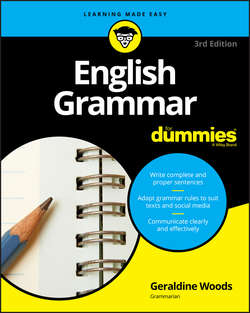Читать книгу English Grammar For Dummies - Woods Geraldine - Страница 5
Part 1
Building a Firm Foundation: The Parts of the Sentence
Chapter 1
Using the Right Words at the Right Time
What This Year’s Sentence Is Wearing: Understanding Grammar and Style
ОглавлениеFresh from the shower, you’re standing in front of your closet. What should you select? Some options aren’t open to you. You can’t show up at work wearing nothing – not if you want to keep your job and, in addition, stay out of jail. That’s a law (in the real world) and a rule (in the world of grammar). You can choose a bright purple jacket and a fluorescent green scarf. The fashion police may object, but real cops will leave you alone. In both the real world and Grammar Land, this sort of decision is a matter of style. A style point is more flexible than a grammar rule. Take that jacket-scarf selection. Your friends may stare and suggest a subtler color combination, or they may praise you for team loyalty if your school colors are purple and green and you’re cheering at a pep rally.
The grammar rules of proper English can and do change, but not often – maybe a few times every 500 years. (Sometimes people break grammar rules on purpose. See the next section, “Distinguishing Between the Three Englishes,” for more information.) Style, on the other hand, shifts much more frequently. A sentence from the early 20th century may look odd to 21st century readers, and a sentence from the 19th century will seem even stranger. Style also changes with context. Science publications and literary journals, for example, capitalize titles differently. Geography matters, too. In the United States, a comma often appears before and in a list of three or more items. British writers generally omit that comma.
In English Grammar For Dummies, 3rd Edition, I discuss the most common style points. If I tackled every situation, though, you’d be reading a thousand-page book. For your most important writing projects, you may want to consult a manual of style. Many institutions publish this sort of book, listing their preferences for punctuation, capitalization, and a whole bunch of other -ations you’ve never heard of. A few popular style manuals are the Modern Language Association Handbook (for academic writing in the humanities), The Chicago Manual of Style (for general writing), the Publication Manual of the American Psychological Association, and the MIT Guide to Science and Engineering Communication (for science writing).
These examples illustrate the difference between grammar and style:
SENTENCE: Am going basketball game I to the.
WHAT’S WRONG: The word order is scrambled.
GRAMMAR OR STYLE? Grammar.
CORRECTED SENTENCE: I am going to the basketball game.
SENTENCE: She was born on March 18 2009.
WHAT’S WRONG: Most writers would insert a comma after 18.
GRAMMAR OR STYLE? Style. Some writers prefer a completely different format for the date.
CORRECTED SENTENCE: She was born on March 18, 2009. Or, She was born on 18 March 2009.
SENTENCE: Them enjoy playing baseball.
WHAT’S WRONG: The word them isn’t appropriate for that spot in the sentence. (Why? Check Chapter 8.)
GRAMMAR OR STYLE: Grammar.
CORRECTED SENTENCE: They enjoy playing baseball.
SENTENCE: Ann spends too much time surfing the Internet.
WHAT’S WRONG: When it was first invented, “Internet” was generally capitalized. These days, many publications prefer lowercase (internet).
GRAMMAR OR STYLE: Style.
CORRECTED SENTENCE: Ann spends too much time surfing the internet.
When you’re speaking or writing, you should take care not to break any grammar rules. You should also follow the style guidelines of the authority figure who’s judging your work. However (there’s always a however in life, isn’t there?), your surroundings, audience, and purpose affect the grammar and style choices you make. For more information, read the next section, “Distinguishing Between the Three Englishes.”
